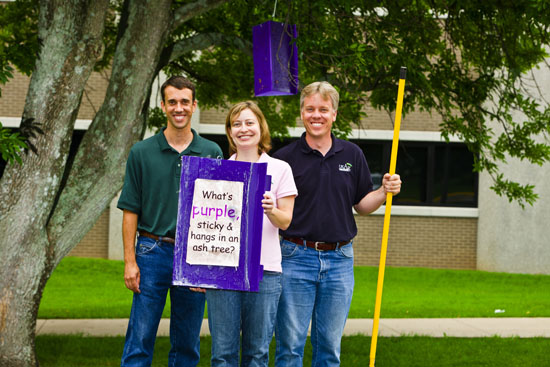2013 pest survey is under way
2013 pest survey is under way

Kentuckians may soon start noticing objects attached to or hanging from trees this spring, and chances are they were put there by personnel from the Kentucky Office of the State Entomologist, which is housed at the University of Kentucky College of Agriculture.
The 2013 Cooperative Agricultural Pest Survey is designed to detect and, in some cases, eliminate exotic pests before they become a problem. The survey is a cooperative effort between the UK College of Agriculture and state and federal agencies. Each year, personnel with the Kentucky Office of the State Entomologist set out thousands of traps targeting several pests and diseases of concern.
“We see these surveys as an integral part of preventing the spread of non-native pests that can cause economic damage to our state,” said Carl Harper, senior nursery inspector.
Harper, along with fellow Office of the State Entomologist personnel Joe Collins, Janet Lensing, Jennie Condra, Katie Kittrell and J. D. Loan, installed the first traps of the season the week of March 4. They will install more throughout the spring.
Insects and diseases they are surveying this year include:
· Emerald ash borer. A native to Asia, the small green metallic beetle was first found in Kentucky in 2009. Several Kentucky counties have the insect, and it can move great distances by the transportation of firewood. About 950 purple prism traps will be placed in ash trees to monitor the spread of the insect in a line roughly from Floyd County to Casey County to Hancock County to the Tennessee border. Biological control measures will be continued with the hopes of reducing the devastating effects of the emerald ash borer.
· Pine shoot beetle. The pine shoot beetle attacks pine trees, killing the tips of the tree by boring into the stems, which then snap off. It’s been discovered in Indiana and Ohio. The traps are a series of black funnels that will hang from a branch or a rope between two trees and will be installed in Northern Kentucky following the Ohio River eastward to Ashland.
· Walnut twig beetle/thousands cankers disease. Thousand cankers disease is the result of the tiny bark beetle that carries a canker producing fungus. As the beetle moves beneath the bark of walnut branches, it creates numerous galleries, resulting in fungal infection and canker formation on the branches. While the beetle is not known to be in Kentucky, it was found in Knoxville, Tenn., in 2010. Other recent finds include around Richmond, Va., and the Great Smoky Mountains in North Carolina. As with the pine shoot beetle, a black funnel trap will be used to monitor for this insect.
· Gypsy moth. The Office of the State Entomologist has surveyed for the gypsy moth for many years, and it has been one of its most successful programs. Infestations have been found three times in the survey in Kentucky and have all been eliminated before they could become established. The pest, one of the most damaging insects to hardwood forests and urban landscapes, is not currently found in the state. Nevertheless, about 4,000 tent-shaped traps will be placed on trees in and around Lexington, Louisville, Land Between the Lakes, Lake Cumberland and from Northern Kentucky to Pike County in Eastern Kentucky, reaching as far south as Montgomery, Menifee and Floyd counties. The traps will be orange, green or brown.
Additionally, inspectors will conduct visual surveys of trees for the hemlock woolly adelgid, Asian longhorned beetle and the disease sudden oak death.
The hemlock woolly adelgid has been a threat to the state’s hemlock trees since it was first found in 2006 in southeastern Kentucky. Surveys for this invasive pest will take place in Eastern Kentucky, where the vast majority of hemlock trees are located. They will continue biological control measures that have been going on for several years.
The Asian longhorned beetle is a known pest of 18 different trees, but it has a preference for maple. It was recently found in Bethel, Ohio. The inspectors will focus most of their efforts on this pest near state parks. Like the emerald ash borer, this pest easily spreads by moving firewood.
Sudden oak death is a major fungal problem in California and Oregon nurseries that results in the death of oak trees. While no instances of this disease have been found in Kentucky, many nurseries and garden centers receive inventory from these two states. Rhododendron, a plentiful plant in Kentucky forests, is a host for this disease. The inspectors will do visual examinations mostly at garden centers and nurseries that receive plants from the West Coast. If symptomatic leaves are found, inspectors will collect and submit them to the UK Plant Disease Diagnostic Laboratory to confirm presence of the disease.
Commodity-specific insect surveys will be conducted in Western and Eastern Kentucky thanks to a grant from the U.S. Department of Agriculture. These surveys target corn, soybean and small grains fields. Inspectors will monitor for a variety of pest insects that haven’t been found in the state before. In a similar survey, inspectors will monitor the presence of insect pests at state parks.
More information about the 2013 surveys is available on the Kentucky Cooperative Agricultural Pest Survey website at http://www.ky-caps.org.
Agricultural Economics Events Extension Forestry & Natural Resources Horticulture

